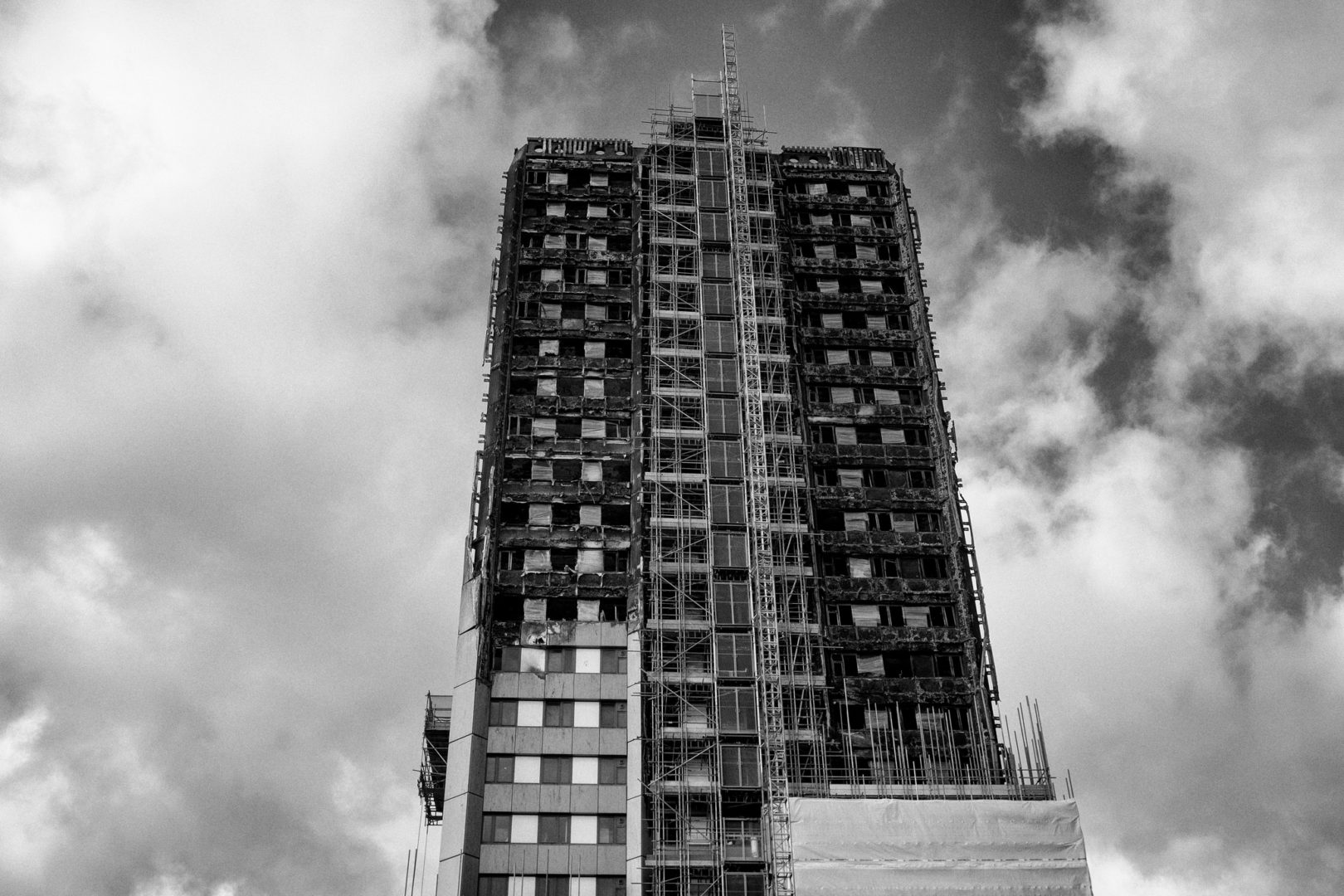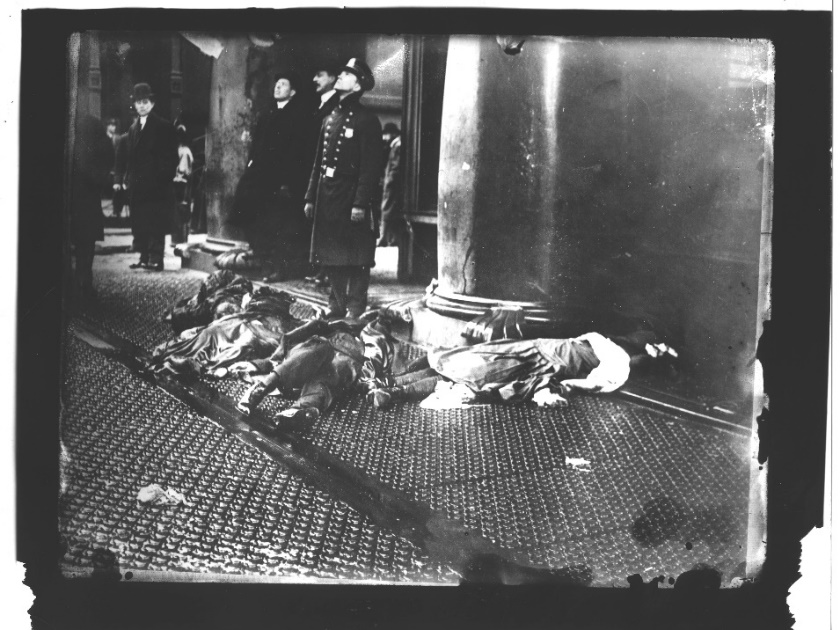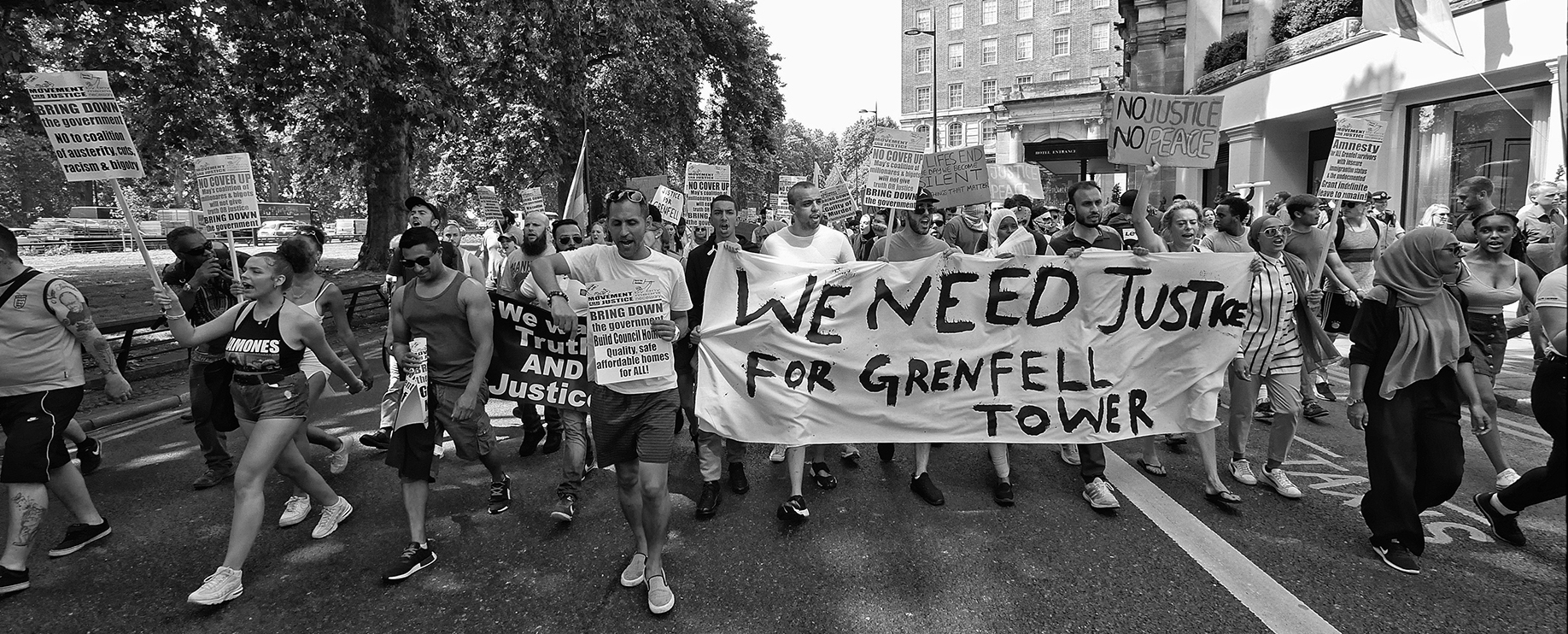Protest march demanding justice for the victims and survivors of the Grenfell Tower fire Photo: The Naked Ape / Flickr
From Triangle to Grenfell: two fires that changed everything
- March 25, 2019
Capitalism & Crisis
The Triangle Shirtwaist Factory fire led to the New Deal — could the Grenfell Tower fire herald the end of neoliberalism and the start of a new politics?
- Author
London. June 14, 2017. Minutes before 1 AM. The fire starts in a kitchen on the fourth floor and within minutes spreads to the outside wall, rising up the building like a firework. Hundreds of people are inside the 24-story Grenfell Tower that starts to burn and melt in the night sky.
The insulation surrounding the tower releases cyanide-laced fumes as it burns; gaps between cladding and the building’s concrete shell funnel oxygen to the blaze as it rips through the building in less than 15 minutes. Firefighter Kylei Holmes-Lewis describes the scene as if “someone had lit a match and they’re holding it vertically.” Walking to the tower she sees “big chunks of concrete and window frames falling down, it looked like a war zone.”
This is highly unusual for a concrete high-rise. What should happen is that firefighters find the source of the fire, isolate it, and put it out. If there is nowhere for the fire to spread, it will go out or be extinguished. Firefighter Dean Roberts speaks of a fire at nearby Trellick Tower two weeks earlier. That fire was contained entirely in one flat, he says, “which is what is expected to happen.”
People trapped in the upper floors at Grenfell are therefore told to stay put for their own safety. So they appear at the windows, look down at the people below and wait. They put towels down at doors to block out smoke as the fire spreads. They wave from windows, tell their families they love them in phone conversations. “Goodbye. I hope I haven’t disappointed you. Goodbye to all,” says Mohamed Neda to his family, his final words before he jumps.
Seventy-two people die.
How did it come to this? It happened because of small gaps; gaps that are created and widened over time. Public provision is delegitimized, cut back, or sold off — creating gaps for the private sector to enter. Working with the government, the private sector lobbies for regulations to be lifted, which the government lifts; researcher Christine Berry notes the “war on red tape” that guided the policy regime in place before Grenfell, something she calls a “murderous war on our protections”. Regulatory gaps widen to become responsibility gaps; institutions are corrupted; people fall through these gaps to their deaths.
Arconic, the American company that manufactured the combustible panels that surrounded Grenfell Tower, stated it “was a manufacturer which supplied a product” in its opening statement to the Grenfell inquiry. “It was for others to decide whether and how the product would be used,” they conclude. And so no one, it seems, is responsible — something highlighted in the 2017 government-commissioned interim report by engineer Judith Hackitt, which described the current regulatory system for high-rise buildings as “not fit for purpose”.
After Grenfell, Labour MP Clive Lewis tweeted: “Burn neoliberalism, not people.”
No escape
On Saturday, March 25, 1911, a different fire breaks out on the other side of the Atlantic, changing the course of US history. At 4:45 PM, on a bright March afternoon, sewing machinists and other garment workers clutch folded pay packets as the bell rings, heralding the end of their shift. There’s singing in the dressing room, laughter and joking among workers in a garment factory which occupies the uppermost three floors of the ten-story Asch building in New York City, as the young Jewish and Italian seamstresses, many of them teenagers, wrap up a six-day, 60-hour work week.
Everything changes in just 15 minutes. A fire breaks out on the eighth floor. It spreads because of the oil-soaked rags that litter the floor under the long rows of sewing machines, and because of the giant scrap bins used to hide child workers when the factory inspectors visit. It spreads because of the paper patterns and fine calico shirts hanging overhead. Workers try to douse the flames with pails of water. They connect the fire hose but it doesn’t work. According to one survivor, forelady Anna Pidone, the fire “danced on the machines” as it rose to the upper floors.
The workers panic. Many, including factory owners Max Blanck and Issac Harris, escape to the roof, where they cross over to a neighboring New York University building. But those on the crowded ninth floor are trapped. No one warns them of the fire. Nobody knows what to do, as there have never been fire drills. They run for the exit doors and struggle to open them but they’re locked from the outside, as they are every day — to prevent theft and stop union organizers getting in.
Some find a fire escape but it buckles under the weight, plunging everyone 80 feet down. After several journeys by the operators, the passenger elevators stop rising due to the heat, and people jump down the elevator shaft in desperation. There’s no escape, and figures appear at the ninth-floor window ledges with flames at their backs.
Firemen’s ladders reach only the sixth floor — 30 feet short of the ninth. Girls kiss, or hug, then jump into the spring air. Because of their hats and long dresses, bystanders mistake them for rolls of fabric until they hear the deep thud, and see a body lying underneath. More jump now, they’re falling to the ground in twos or threes, holding hands. Firemen stretch out life nets to catch them but they snap.
Police cordon off the area and hold back the gathering crowd; the same police who, only a year earlier, arrested strike leader Clara Lemlich 17 times during the 1909 “Uprising of 20,000” — a strike of garment workers which failed to gain union recognition and better safety standards. The same policemen now watch the workers fall like rain. In the end, 146 of the 500 workers die — dozens by jumping from the burning building — in one of the worst industrial accidents in US history.
The day the New Deal began
Disasters are social x-rays. Passing through our taken-for-granted assumptions, they expose the deep structures of our beliefs and deprive us — at least for a time — of our common excuses and justifications, revealing our condition with surgical clarity.
In The Condition of the Working Class in England, Friedrich Engels diagnosed what he saw in the factories of industrial Manchester as “social murder” — the maimings, the mangled bodies, the avoidable deaths of young men, women and children dying “as much a death by violence as that by the sword or bullet.” But acts of social murder can only emerge in environments of bewildering change, such as the shift from artisan production to factory production in the 19th century, or the shift from an industrial to a post-industrial economy many countries are undergoing now. It then takes the clarity of loss to wake people from their torpor, to rouse institutions from their complacency; it takes a deep psychological transformation to open a path for radical social reform.
Yet the responses to the two disasters differed. The Triangle fire became what experts call a “focusing event”, an incident that moves minds and sparks change, whereas Grenfell has been made a forgotten event. Ten days after the Triangle fire the International Ladies’ Garment Workers’ Union (ILGWU) organized a procession to honor the victims of the fire. 120,000 people marched, many under union banners, while 300,000 lined the streets of Manhattan to watch.
Frances Perkins, then a young social worker and an eyewitness to the fire, reported the collective mood that fell over the city: “This made a terrible impression on the people of the State of New York. I can’t begin to tell you how disturbed the people were everywhere. It was as though we had all done something wrong. It shouldn’t have been. We were sorry. Mea culpa! Mea culpa!”
The Triangle fire, the anger generated in its aftermath and pressure from union activists led to the formation of the Factory Investigating Commission “to investigate the conditions under which manufacturing is carried on” in New York State. The Commission’s investigations, done in 1911 and 1912, included visits to factories, public hearings, and testimony from hundreds of witnesses (including employers, union officials and workers) that ran to more than 7,000 pages, and Commission members relentlessly pushed the scope of the Commission’s work beyond its remit. Many of its recommendations subsequently became law and mandated improved ventilation, sanitation, and machine guarding, as well as better fire safety measures.
These laws served as a model for other US states, laying the groundwork for the New Deal 20 years later. Perkins, appointed chief investigator of the Factory Investigating Commission, later claimed that March 25, 1911 was “the day the New Deal began.”
Fleeing the violence of poverty
Perhaps the Grenfell disaster showed signs of something similar — but the blazing rage and calls for action were quickly dampened down. Newspapers ran stories that scapegoated Grenfell residents, drawing attention to the number of immigrants living in the building. “First pictures of mini cab driver whose faulty fridge started Grenfell Tower fire,” read one tabloid headline, insinuating that one resident, a 41-year-old Ethiopian taxi driver, was in some way responsible for the fire.Any collective mood that might have ignited change was diverted, individualized and then vanished like a cloud; the inquiry into the fire was given a narrow remit, stopping short of analyzing wider issues such as social housing policy as residents and campaigners had hoped.
As with Grenfell, many of those who died in the Triangle fire were fleeing the violence of poverty, or just seeking a better life in a new country; victims from both died through the callous indifference of officials and the refusal to pay for simple measures that would have saved lives. Both disasters held up a mirror; yet while the Triangle fire roused people to action across class and ethnic lines, Grenfell descended into what Sam Knight, writing in the New York Times, called “a kind of civic dysfunction” and a culture of “radical distrust” between survivors and the authorities. And this distrust has only grown.
Andrew O’Hagan’s 60,000-word establishment-friendly jeremiad in the London Review of Books poured more salt into an open wound. In response, Josie Michelle, in a piece for New Socialist, writes that O’Hagan’s account “involves casting the disempowered, traumatized survivors of an horrific incident as unreliable narrators, whilst offering sympathetic watercolor profiles of those in possession of political and social power,” in what looks like an ongoing public relations campaign to whitewash the authorities and cloud the lines of responsibility at play.
Likewise, the recent UK Channel 4 Dispatches documentary “Grenfell: Did the Fire Brigade Fail?” rightly pointed out deficiencies in the Fire Brigade’s readiness and response to the fire, but failed to ask the right questions of those who hold power. So what explains the two different reactions to two similar fires?
Grenfell in the eye of global capitalism
There are three aspects specific to Grenfell that help to explain this. First, Grenfell occurred in London, one of the central nodes of a global financialized economy whose driving principle, in the words of sociologist Saskia Sassen, is “the enclosure by financial firms of a country’s resources.” The loosening of building regulations, the capture of regulatory agencies and the rush to outsource public services and generate revenue at all costs must be seen as the symptoms of finance power working in tandem with local elites — as London’s local authorities have become world leaders in the “social cleansing” of council tenants and the transfer of public assets into private hands.
Here, the city, as Anna Minton writes in Ground Control, becomes a “private business, accountable to property developers and retailers rather than local electors”, a series of “safe” spaces blending the clinical and the corporate: dark glass towers patrolled by 24-hour security guards, CCTV and street furniture with spikes to deter the homeless — places, or rather intermediary zones in which, through our repeated encounters with the logics of spatial exclusion, “we become fearful and less trusting” as a result.

The burnt-out Grenfell Tower. photo by Guido van Nispen / Flickr
Second, Grenfell took place in a social context that demonizes the poor and their housing. The opening statement to the Grenfell inquiry on behalf of the deceased, survivors, families and victims (the group known as G10) drew attention to the commonly held belief that “council housing is for those who have failed in life. People who need to be managed, not embraced or admired,” a stereotype that “allowed the cost cutting and the use of deadly materials to become normalized.”
Third, the Grenfell fire occurred in a society made weak and brittle by a generation of neoliberal individualism and its negation of collective ties. The public reaction in the immediate aftermath of the fire, the hundreds of paper messages left on the Grenfell Wall, the free holidays for survivors, and the selfless local response brought the failings of this grossly unequal society into focus: a society with the highest wage inequality in Europe, and a society with 14 million people in poverty, including 4.5 million children, according to food bank charity the Trussell Trust.
John Boughton, in this book Municipal Dreams, writes that “Grenfell showed us community, strong and diverse; families, friends, and neighbors together.” Yet paradoxically, it’s precisely because Grenfell Tower was such an effective “social condenser” that some would have preferred if it was consigned to history — nobody likes to be reminded of what they have lost.
In societies that have determined that community cannot exist, or that community (if permitted at all) must be thin, transient and subservient to finance capital, the long-standing and diverse communities of Grenfell — characterized by what activist Raquel Gutiérrez calls “communitarian weavings” — evoke dreams that cannot be permitted to linger. For who knows what might happen if we started thinking in terms of communities again?
Honoring the dead
Every year on March 25, living descendants of those who died in the Triangle fire assemble outside the Asch building at the corner of Washington Place and Greene Street. They read out the names of the deceased and place 146 white carnations on the sidewalk with the victims’ names attached. To honor workers who have died in today’s garment factory fires in Bangladesh, Thailand, China and elsewhere, red carnations are also laid.
Just as the Triangle Shirtwaist Factory fire led to the New Deal, so should Grenfell be a tomb for neoliberalism, a grave for an era of socially-sanctioned selfishness, and the start of a new politics.
Perhaps after the fire marking the end of neoliberalism we’ll see social dreaming and political wrestling we can’t yet imagine, new forms of solidarity growing out of ashes. A poem by Ben Okri asks us to honor the past, but also to look forward: “If you want to see how the poor die, come see Grenfell Tower. See the tower, and let a world-changing dream flower.”
Because these two fires call on us to build a better world than this one; a world where human lives and communities matter more than profits; a world in which to fall means to be caught, and held.
Source URL — https://roarmag.org/essays/triangle-factory-grenfell-tower-fires/



